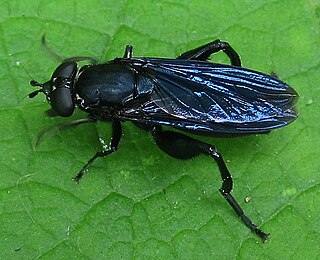
Blera is primarily a North American genus, though there are 3 species from Europe. The genus is characterized by the following characters:

Chalcosyrphus is a genus of hoverflies in the subfamily Eristalinae. Many species exhibit some degree of mimicry of various sawflies and other hymenopterans and are often brightly coloured or metallic in hue. The adults are similar in structure and behavior to the related genus Xylota but differ in larval morphology. They can be found throughout Europe, Asia, and North America and seem to prefer damper, boggy habitats. The larvae are saproxylic feeders in rotten wood in these habitats.

These are small black and yellow or mostly black flies with a narrow abdomen near the thorax. They occur mainly in damp places among low herbage. The larva of Neosascia are flattened without oral hooks and a have a short posterior spiracular process or "tail" rat-tailed that is saprophagous. In 1925 Curran reviewed the genus Neoascia. In this work a key is provided and ten species are described including four new species some of which have later been determined to be synonyms.

Neoascia podagrica is a species of hoverfly.

Tropidia is a genus hoverflies, from the family Syrphidae, in the order Diptera.

The Brachyopini is a tribe of hoverflies. Unlike many members of this family these flies are generally darker and less colourful though some genera contain species with an attractive metallic lustre e.g. Chrysogaster. Some like Brachyopa are associated with sap runs where their larvae feed on decaying sap. Others are found in boggy areas where their often semiaquatic larvae feed on decaying organic matter.

Neoascia meticulosa is a species of hoverfly.

Neoascia tenur is a Palearctic species of hoverfly.
Neoascia metallica, the Double-banded Fen Fly, is a common species of syrphid fly observed across North America. Hoverflies can remain nearly motionless in flight. The adults are also known as flower flies, for they are commonly found on flowers, from which they get both energy-giving nectar and protein-rich pollen. The larvae are aquatic.

Hadromyia pulchra is a species of hoverfly in the family Syrphidae.

Hadromyia grandis is a species of hoverfly in the family Syrphidae.

Sphecomyia is a genus of hoverfly in the family Syrphidae. There are about 16 described species in Sphecomyia.
Sphecomyia pattonii is a species of syrphid fly in the family Syrphidae.

Chalcosyrphus (Xylotomima) metallifer , the Orange-horned Leafwalker, is a rare species of syrphid fly observed in the Eastern United States. Hoverflies can remain nearly motionless in flight. The adults are also known as flower flies for they are commonly found on flowers, from which they get both energy-giving nectar and protein-rich pollen.
Tropidia coloradensis is a species of hoverfly in the family Syrphidae.
Neoascia sphaerophoria is a species of Hoverfly in the family Syrphidae.
Neoascia subchalybea is a species of Hoverfly in the family Syrphidae.

The Spheginina is a subtribe of hoverflies.
Total of 245 species either found or highly expected to be found in New York.











